The request for an orthodontic treatment by patients is often motivated by the desire to improve the appearance of their smiles: more and more often they ask for an orthodontic appliance that is little annoying and completely invisible. In these cases it is possible to carry out a fixed lingual orthodontics without brackets, an innovative technique devised by Prof. Aldo Macchi in the early Nineties and first published in Italy and abroad by Prof. Macchi himself and by Dr. Nunzio Cirulli ( Macchi A, Cirulli N. “Fixed Active Retainer for Minor Anterior Tooth Movement”. Journal of Clinical Orthodontics, 2000; Macchi A, Rania S, Cirulli N . “Una proposta per la gestione di disallineamenti anteriori: il mantenitore attivo di contenzione (MAC)“).
This technique, which has undergone constant evolution over the years, has got the advantage of combining the invisibility feature of the therapy and the great comfort due to the absence of brackets touching the tongue.
The patient under examination in this work presented a Class I dental malocclusion characterized by a severe crowding of the mandibular arch (pics 1-6) and marked uneasiness in performing everyday home dental hygiene.

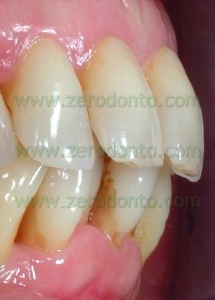
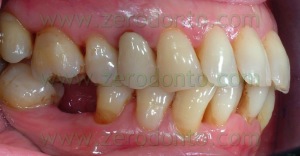
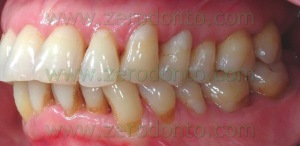

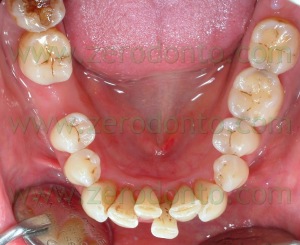
The request for an invisible and little annoying treatment made by the patient drove us to carry out a lingual therapy without brackets, in this case using active retainers (pic 7).

These are devices made using a 0.175 inches thick interweaved steel wire commonly used to make fixed retainers. This wire is shaped making first and second order bends and further activated according to the laws of biomechanics. In order to regain the necessary space to achieve the alignment, it was decided to perform a stripping procedure from 36 distal to 45 distal in addition to the expansion.
The first retainer used was shaped so that it could passively fit to the lingual surface of the teeth from 34 to 44, except for the 31, and at interdental level with vertical U-loops (about 2 mm wide and 4-5 mm long). Loops are added in order to increase the elastic properties of the wire and, as it will be explained during the bonding procedure, will make it possible to activate the device in order to achieve the arch expansion.
The retainer was further activated opening the loops of about 2 mm and bending the part of the wire to be bonded on teeth 32 and 41 buccally and the one to be bonded on the canines lingually.
The adhesion procedure for the device is carried out etching the lingual surfaces with orthophosphoric acid for 30 seconds. After drawing in the etching agent, washing generously with water and blowing air till seeing the dehydrated surface of the enamel, the adhesive is applied and polymerized.
At this point the wire is put in place and covered with a 2 mm thick medium viscosity fluid composite layer. The bonding procedure is also fundamental to achieve the sought after dental shift. In this case the retainer was first bonded on the 41 and then, after closing the loops of about 2 mm, on the 32 and 42. When the loops are being closed and during the bonding phase it is paramount not to turn the wire over and to keep the horizontal plane – e.g. with the help of two utility tools – in order to avoid unwanted vertical shifts.
Afterwards the retainer was bonded on the mesial dimples of the fourths, usually not in occlusion with the antagonist arch, always closing the loops as previously described.
At this point the part of retainer to be bonded on the canines, previously activated bonding it lingually, is turned over on the lingual surface of those dental elements using a utility tool and bonded. This way the retainer, activated in buccal-lingual direction, will make the alignment possible while the loops make room.
The patient was checked every 3 weeks and every time the retainer was detached from the teeth to be activated in order to reactivate it and bond it again. The detachment was obtained using a low-speed bur under continuous irrigation to wear the layer of composite surrounding the wire down without reaching it in order to prevent any possible damage. For this reason the layer of composite close to the wire is not worn down and the retainer is detached using a probe or a utility tool as a lever between tooth and wire. After the reactivation of the device the bonding is performed without the need to etch again, simply applying the adhesive on the layer of composite still present on the teeth and coarsened with a diamond bur.
Only after an initial phase of expansion a segment of retainer was bonded on the 31, in overlay on the 32 and 42, to start to move the 31 lingually as soon as there was some space (pic 8).
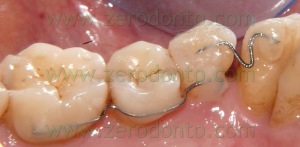
As previously mentioned, a stripping procedure was necessary to align the dental elements without an excessive expansion. The spaces resulting from the stripping were used to move first the premolars and then the canines distally in order to obtain further space for the alignment. In picture 8 we can notice a particular right because of the distalization of the canines: .018 x .022 steel wire stabilizing sectionals shaped to fit to the lingual surface of the first molar and of the premolars. This was done in order to move the canines distally by means of loops shaped with retainer wire and opened of about 2 mm when stuck.
A single retainer was put on when the achieved space was sufficient to align the anterior group (pic 9).
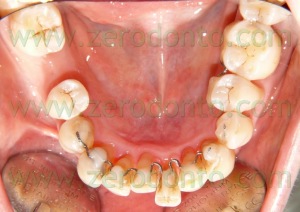
The therapy was carried out for about a year, with a 15 minute (on average) check-up every 3 weeks.
When the alignment was achieved a passive retainer was put on (pic 10).
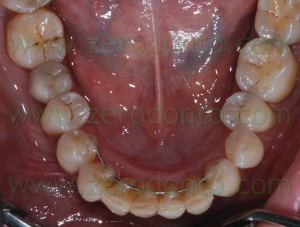
Bibiography:
1. Macchi A, Cirulli N. “Fixed Active Retainer for Minor Anterior Tooth Movement”. Journal of Clinical Orthodontics, 2000.
2.Macchi A, Rania S, Cirulli . “Una proposta per la gestione di disallineamenti anteriori: il mantenitore attivo di contenzione (MAC)”. Mondo Ortodontico, 1999.
3.Mariniello A, Cozzolino F. Lingual active retainers to achieve teeth levelling in orthodontics: case series. International Dentistry SA Vol 10 N 5, pag. 24-29, 2008.
For information:
zerodonto@gmail.com
tel. 0039 081 2451805

